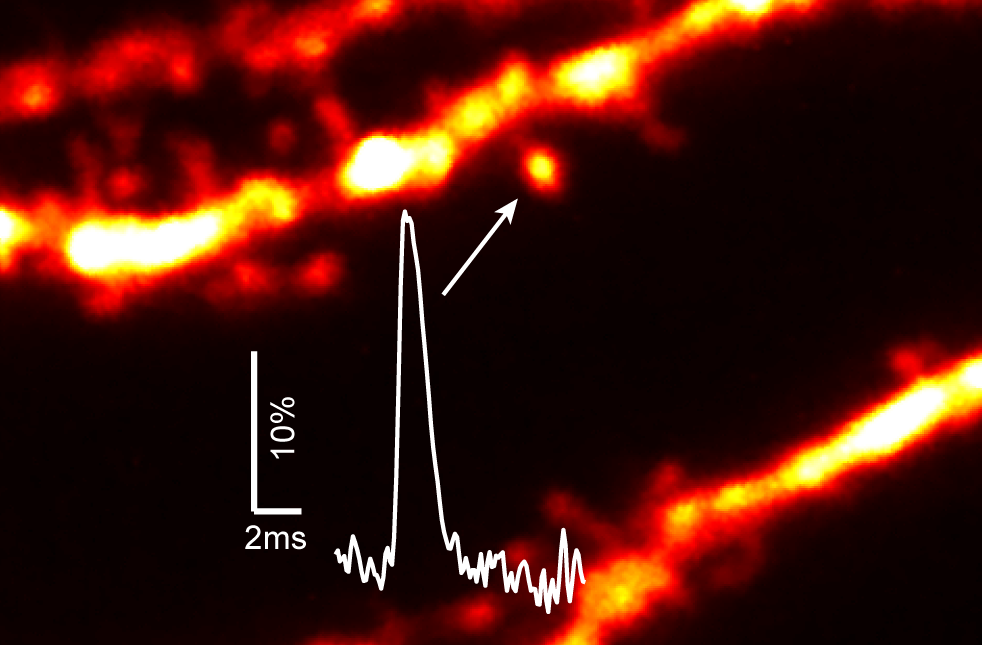Neuroscience Research
Voltage-sensitive dyes for neuroscience research
Voltage-sensitive dyes are currently used to study diverse, fundamental questions in neuroscience research using a large variety of cell, tissue, and whole animal assays (3). Dye selection and details of imaging techniques contribute to the overall signal-to-noise obtained.

When selecting a voltage-sensitive dye (VSD) for neuroscience research purposes, dye sensitivity, staining, brightness, response dynamics are among the chief considerations in choosing the best dye for a given application. One the imaging side, techniques range from simple 1-photon epifluorescence to more advance ratiometric and 2-photon excitation methods. 2-photon excitation may be used to record from single dendritic spines (1) or axonal bouttons (2). Dyes have diverse spectral properties including red-shifted dyes.
)Key products and applications
Di-4-ANEPPS along with Di-8-ANEPPS are classic voltage-sensitive dyes with rapid response kinetics that have been used for neuronal recordings for decades (5). Although limited by sensitivity, dyes of this kind can provide excellent signal-to-noise based on brightness and photostability. Additionally, ratiometric techniques (4) may be employed for artifact removal such as slow bleaching or rapid movement artifacts. More recently, fluorinated dyes (6) such as ElectroFluor530TM (aka Di-4-AN(F)EPPTEA) and ElectroFluor560TM (aka Di-4-AN(F)EP(F)PTEA) were developed for improved signal-to-noise and these patented dyes promise to take over from the classic dyes as the new work horses of voltage imaging.
Long wavelength dyes such as Di-4-ANBDQBS and Di-4-ANBDQPQ were developed for improved sensitivity and spectral compatibility with blood infused, whole-heart preparations. While more established in the cardiac field, these dyes may be equally useful for neuroscience researchers looking for long wavelength probes.
Citations
- Acker, C. D., E. Hoyos, and L. M. Loew. 2016. EPSPs Measured in Proximal Dendritic Spines of Cortical Pyramidal Neurons. eNeuro 3(2). Pubmed
- Rowan, M. J., E. Tranquil, and J. M. Christie. 2014. Distinct kv channel subtypes contribute to differences in spike signaling properties in the axon initial segment and presynaptic boutons of cerebellar interneurons. J Neurosci 34(19):6611-6623. Pubmed
- Canepari, M., and D. Zecevic, editors. 2010. Membrane Potential Imaging in the Nervous System: Methods and Applications. Springer, New York.
- Bullen, A., and P. Saggau. 1999. High-speed, random-access fluorescence microscopy: II. Fast quantitative measurements with voltage-sensitive dyes. Biophys J 76(4):2272-2287. Pubmed
- Loew, L. M., L. B. Cohen, J. Dix, E. N. Fluhler, V. Montana, G. Salama, and J. Y. Wu. 1992. A naphthyl analog of the aminostyryl pyridinium class of potentiometric membrane dyes shows consistent sensitivity in a variety of tissue, cell, and model membrane preparations. J Membr Biol 130(1):1-10. Pubmed
- Yan, P., C. D. Acker, W. L. Zhou, P. Lee, C. Bollensdorff, A. Negrean, J. Lotti, L. Sacconi, S. D. Antic, P. Kohl, H. D. Mansvelder, F. S. Pavone, and L. M. Loew. 2012. Palette of fluorinated voltage-sensitive hemicyanine dyes. Proceedings of the National Academy of Sciences of the United States of America 109(50):20443-20448. Pubmed
- Matiukas, A., B. G. Mitrea, M. Qin, A. M. Pertsov, A. G. Shvedko, M. D. Warren, A. V. Zaitsev, J. P. Wuskell, M. D. Wei, J. Watras, and L. M. Loew. 2007. Near-infrared voltage-sensitive fluorescent dyes optimized for optical mapping in blood-perfused myocardium. Heart Rhythm 4(11):1441-1451. Pubmed
